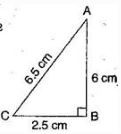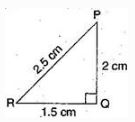Class 6 - Mathematics
Chapter - Triangles and its Properties : Exercise 6.5

Top Block 1
Question : 1.PQR is a triangle, right angled at P. If PQ = 10 cm and PR = 24 cm, find QR.
Answer :
Given: PQ = 10 cm, PR = 24 cm
Let QR be x cm.

(Hypotenuse)2= (Base)2 + (Perpendicular)2 [By Pythagoras theorem]
⇒ (QR) 2= (PQ)2 + (PR)2
⇒ 𝓍 2=(10)2 + (24)2
⇒ 𝓍 2 = 100 + 576 = 676
⇒ 𝓍 = √676 = 26 cm
Thus, the length of QR is 26 cm.
Question : 2.ABC is a triangle, right angled at C. If AB = 25 cm and AC = 7 cm, find BC.
Answer :
Given: AB = 25 cm, AC = 7 cm

Mddle block 1
In right angled triangle ACB,
(Hypotenuse)2= (Base)2 + (Perpendicular)2 [By Pythagoras theorem]
⇒ (AB)2= (AC)2 + (BC)2
⇒ (25)2=(7)2 + (𝓍)2
⇒ 625 = 49 + (𝓍)2
⇒ 49 + (𝓍)2 = 625 – 49 = 576
⇒ 𝓍 = √576 = 24 cm
Thus, the length of BC is 24 cm.
Question : 3.A 15 m long ladder reached a window 12 m high from the ground on placing it against a wall at a distance a. Find the distance of the foot of the ladder from the wall.

Answer :
Let AC be the ladder and A be the window.
Given: AC = 15 m, AB = 12 m, CB = a m

(Hypotenuse)2 = (Base)2 + (Perpendicular)2 [By Pythagoras theorem]
⇒ (AC)2 = (CB)2 + (AB)2
⇒ (15)2 = (a)2 + (12)2
⇒ 225 = (a)2 + 144
⇒(a)2 = 225 – 144 = 81
⇒ a = √81 = 9 cm
Thus, the distance of the foot of the ladder from the wall is 9 m.
Question : 4.Which of the following can be the sides of a right triangle?
2.5 cm, 6.5 cm, 6 cm
2 cm, 2 cm, 5 cm
1.5 cm, 2 cm, 2.5 cm
In the case of right angled triangles, identify the right angles.
Answer :
Let us consider, the larger side be the hypotenuse and also using Pythagoras theorem,
(Hypotenuse)2 = (Base)2 + (Perpendicular)2
(i) 2.5 cm, 6.5 cm, 6 cm

L.H.S. = (6.5)2 = 42.25 cm
R.H.S. = (6)2 + (2.5)2 = 36 + 6.25 = 42.25 cm
Since, L.H.S. = R.H.S.
Therefore, the given sides are of the right angled triangle.
Right angle lies on the opposite to the greater side 6.5 cm, i.e., at B.
(ii) 2 cm, 2 cm, 5 cm
(5)2=(2)2+(2)2
L.H.S. = (5)2 = 25
R.H.S. = (2)2+(2)2 = 4 + 4 = 8
Since, L.H.S. ≠ R.H.S.
Therefore, the given sides are not of the right angled triangle.
(iii) 1.5 cm, 2 cm, 2.5 cm

L.H.S. = (2.5)2 = 6.25 cm
R.H.S. = (1.5)2+(2)2 = 2.25 + 4 = 6.25 cm
Since, L.H.S. = R.H.S.
Therefore, the given sides are of the right angled triangle.
Right angle lies on the opposite to the greater side 2.5 cm, i.e., at Q.
Question : 5.A tree is broken at a height of 5 m from the ground and its top touches the ground at a distance of 12 m from the base of the tree. Find the original height of the tree.
Answer :
Let A’CB represents the tree before it broken at the point C and let the top A’ touches the ground at A after it broke. Then ΔABC is a right angled triangle, right angled at B.
AB = 12 m and BC = 5 m

(AC)2 = (AB)2 + (BC)2
⇒ (AC)2 = (12)2 + (5)2
⇒ (AC)2 = 144 + 25
⇒ (AC)2 = 169
⇒ AC = 13 m Hence, the total height of the tree = AC + CB = 13 + 5 = 18 m.
Question : 6.Angles Q and R of a ΔPQR are 25o and 65o.
Write which of the following is true:
PQ2 + QR2 = RP2
PQ2 + RP2 = QR2
RP2 + QR2 = PQ2
Answer :
In ΔPQR,
∠PQR + ∠QRP + ∠RPQ = 180o [By Angle sum property of a Δ ]
⇒ 25o + 65o + ∠RPQ = 180o
⇒ 90o + ∠RPQ = 180o
⇒∠RPQ = 180o – 90o = 90o
Thus, ΔPQR is a right angled triangle, right angled at P.
∴ (Hypotenuse)2 = (Base)2 + (Perpendicular)2 [By Pythagoras theorem]
⇒ (QR)2 = (PR)2 + (QP)2
Hence, Option (ii) is correct.
Question : 7.Find the perimeter of the rectangle whose length is 40 cm and a diagonal is 41 cm.
Answer :
Given diagonal (PR) = 41 cm, length (PQ) = 40 cm

Now, in right angled triangle PQR,
(PR)2 = (RQ)2 + (PQ)2 [By Pythagoras theorem]
⇒ (41)2 = 𝓍2 + (40)2
⇒ 1681 = 𝓍2 + 1600 ⇒ x2 = 1681 – 1600
⇒ 𝓍2 = 81
⇒ 𝓍 = √81 = 9 cm
Therefore the breadth of the rectangle is 9 cm.
Perimeter of rectangle = 2(length + breadth)
= 2 (9 + 49)
= 2 x 49 = 98 cm
Hence the perimeter of the rectangle is 98 cm.
Question : 8.The diagonals of a rhombus measure 16 cm and 30 cm. Find its perimeter.
Answer :
Given: Diagonals AC = 30 cm and DB = 16 cm.
Since the diagonals of the rhombus bisect at right angle to each other.

And OC = AC⁄2 = 30⁄2 = 15 cm
Now, In right angle triangle DOC,
(DC)2 = (OD)2 + (OC)2 [By Pythagoras theorem]
⇒ (DC)2 = (8)2 + (15)2
⇒ (DC)2 = 64 + 225 = 289
⇒ DC = √289 = 17 cm
Perimeter of rhombus = 4 x side
= 4 x 17 = 68 cm
Thus, the perimeter of rhombus is 68 cm.

